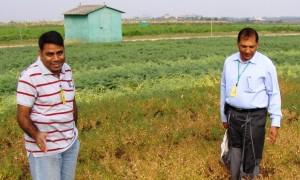Breathing life into support services
By addressing the needs at the heart of quality agricultural research, right there on the station, GCP was the first to cotton on to a crucial missing link between researcher, research station, and support services.” – Hannibal Muhtar
Want to cut to the chase and only need the bare bones of this story? Skip over to the short version
“One thing that really energises me,” enthuses GCP Consultant Hannibal Muhtar, “is seeing people understand why they need to do the work, and being given the chance to do the how.” And so was born another wonderfully fruitful GCP collaboration. Hannibal, who describes the assignment as “a breath of fresh air,” was asked to identify, together with GCP project Principal Investigators, African research sites of ongoing or potential GCP Research Initiative projects where effective scientific research might be hampered by significant gaps in one fundamental area: infrastructure, equipment and support services.
Meet Hannibal Muhtar (Audio clip)
As at June 2012, the 19 sites selected were:
Burkina Faso – L’Institut de l’environnement et de recherches agricoles sites at :
1. Banfora
2. Farako-Bâ Regional Centre
Ethiopia
3. Hawassa Agricultural Research Station
4. The Southern Agricultural Research Institute
Ghana – Council for Scientific and Industrial Research, Crops Research Institute sites at:
5. Kumasi
6. Tamale
Kenya
7. Moi University (site 1)
8. Moi University (site 2)
9. Egerton University (Njoro site)
10. Egerton University (Koibatek Farmers Training Centre)
Mali – L’Institut d’Économie Rurale sites at:
11. Sotuba
12. Cinzana
13. Longrola
Niger – ICRISAT site
14. Sadore
Nigeria
15. National Cereals Research Institute
National Root Crops Research Institute sites at:
16. Umudike
17. Kano
Tanzania – Agricultural Research Institute at:
18. Naliendele
19. Mtwara

Flashback to 2010. Picture on the left: Hannibal at a planning session at Sega, Western Kenya, with Samuel Gudu and Onkware Augustino. Picture on the right: Similarly, at Naliendele, in Tanzania with Omari Mponda.
Embarking on the voyage to change, storms ‘n’ all
Hannibal, armed with years of practical experience in the application of engineering sciences in agriculture and developing countries, as well as an attentive ear to the real needs of researchers, embarked on a series of visits to these research stations in 2010 and 2011, meeting with staff of all levels, departments and functions, carrying out in-depth analyses and draw up concrete recommendations for infrastructure and support service investments for each of the sites so that good-quality field evaluations (‘phenotyping’ in ‘breeder-speak) of GCP-funded projects could be conducted. Thanks to funding from GCP’s Integrated Breeding Platform (IBP), and to the openness, commitment and energy of research staff on the ground to implement these recommendations, the efforts of multiple cross-cutting partnerships across Sub-Saharan Africa are, in 2012, starting to bear fruit. But it has not all been smooth sailing, and the storms encountered along the way to reach this end goal should not be underestimated.
Weeds, wear and tear, and a walk on the wild side
The obstacles, says GCP’s Director of Research, Xavier Delannay (pictured, can often be mundane in nature – a lack of or faulty weather stations or irrigation systems, or fields ravaged by weeds or drainage problems and in dire need of rehabilitation, for example. Yet such factors compromise brilliant research. A simple lack of fencing, Xavier and Hannibal expound, commonly results not only in equipment being stolen, but also in roaming cattle and wild animals – boars, monkeys, hippopotamus and hyena, to name but a few – stomping over precious experiment sites and posing serious threats to field staff safety. “The real challenge lies not in the science, but rather in the real nuts-and-bolts of getting the work done in local field conditions,” he explains.’’
Hannibal concurs: “If GCP had not invested in these research support infrastructure and services, then their investment in research would have been in vain. Tools and services must be in place as and when needed, and in good working order. Tractors must be able to plough when they should plough.’’
But a critical change is also needed in mindset and budgeting. ‘’The word ‘maintenance,’’’ a Senegalese partner commented to Hannibal, describing his institute, “does not exist in our vocabulary and is not a line-item on our budget.”
The problem then is not always about limited funds but rather much more on how the funds available are budgeted, excluding the all-essential support services.
Getting down to the brass tacks of local empowerment, and aiming higher
Multi-lingual and fluent in English, Arabic and French, Hannibal employed a multi-faceted customised approach, based on the needs of each site, be it sharing his tricks-of-the-trade and improvising local solutions, or guiding researchers in identifying their specific needs, as well as on where and how to request equipment, just to mention a few examples. In other cases he would teach local station managers to build and apply simple yet revolutionary tools such as land-levellers (referred to as ‘floats’ in industrial-speak), as well as row-markers for more uniform spacing between rows and plants in the field.
In addition, he would organise a training workshops in either English or French, with different content for technicians, machine operators and station managers. The dedication demonstrated by this latter group to both learn and continue these efforts after the training was particularly pertinent for ensuring the long-term sustainability of the investments.
A colourful menu of options, then, for achieving one common overarching objective, which, as summarised neatly by Xavier, is: “The effective running of local experiment stations, for facilitating local research, improving local crops, and ultimately leading to empowerment and self-reliance of local farming communities.”
“At the end of the day, it’s about achieving food security and improving livelihoods,” Hannibal emphasises. Looking back at some of the research stations that are now well-equipped and are being managed well, and the improved crop varieties being produced and projected, Hannibal highlights the “harmonious chain” triggered as a result: “Food security and better livelihoods pave way for healthy, well-fed families, and agriculture growing beyond subsistence into an economic activity,” Hannibal concludes.
Lights, curtain… ACTION!
Much like in theatre, with all the ‘props’ in place, Hannibal reports that field trials are now performing well, thanks to the all-important ‘backstage’ support service elements being in good shape. Hannibal likens the positive feedback from the partners he has worked with to “A glass of cold water, after a long day in the sun!”
And there’s a beautiful simplicity to the impacts described: “With proper infrastructure in place, and with research station staff duly equipped with the hands-on expertise and practical know-how to utilise and apply this infrastructure and training, we’re now seeing field experiments being conducted as they should be, and getting good-quality phenotyping data as a result,” says Xavier. “Moreover,” he continues, “by providing glass-houses or the capacity to irrigate in the dry season, we are enabling breeders to accelerate their breeding cycles, so that they can work all year round, rather than having to wait until the rain comes.” Sites hosting GCP projects on rice in Nigeria, as well as on sorghum and rice in Mali, are just a few examples of those enjoying off-season work thanks to new irrigation systems.
Similar good news is expected soon for cassava in Ghana and in northern Nigeria. And yet more good news: in some cases, the impacts have not been limited to the trials, or even to the research trials and stations alone, as Xavier highlights with an example from Kenya: “The establishment of an irrigation system on a plot at Koibatek Farmer Training Centre – a partner of Egerton University – yielded excellent results for chickpea experiments. We emphasised that we did not want the equipment to be ‘bracketed’ exclusively for science and experiments. So, it was also used to train staff and farmers from the local community as well. This was greatly appreciated.”
Seeing the nuts-and-bolts now firmly in place for the majority of the sites visited, Hannibal believes GCP has facilitated a pioneering approach to local capacity building: “By addressing the needs at the heart of quality agricultural research, right there on the station, GCP was the first to cotton on to a crucial missing link between researcher, research station, and support services,” he reveals.
…Another missing link…
But the job is not quite done. One crucial gap is the sensitisation of upper management – those at the helm of national research institutes and research station Directors – to support and sustain infrastructure, training and related services. In some cases, costs could be easily met by utilising a priceless asset that most institutes already have, and which they could put to greater us – land and a controlled environment.
Upper management needs to be actively on board. “A research institute should work like a good sewing machine,” says Hannibal. “All well-oiled, all parts working well, and everybody knowing what they need to do.”
In the meantime, however, results from the field suggest that researchers in GCP projects are already reaping the benefits from improved infrastructure and support services, and are already off to a good start.
The stage is therefore set: backstage and props are well primed, performance trials are acting like they should, and the ‘theatre directors’ have an eye on sustainability after GCP’s final curtain call in 2014.
So, long may the show go on, with a cautionary word, however, to continually seek ways to not only maintain but also enhance performance!
Relevant links
- PODCASTS: You can also listen to Hannibal, by tuning into Episode 2 for the entire interview, or zooming in on your particular area of interest in the mini-podcasts labelled Episodes 2.1 to 2.7 c here.
- Capacity building
- Research Initiatives
- Integrated Breeding Platform website
 Fikre Asnake (pictured) is a researcher and breeder in both Tropical Legumes I and II projects (TLI and TLII), working at the Ethiopian Institute of Agricultural Research (EIAR).
Fikre Asnake (pictured) is a researcher and breeder in both Tropical Legumes I and II projects (TLI and TLII), working at the Ethiopian Institute of Agricultural Research (EIAR).













